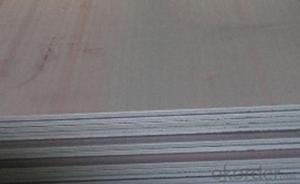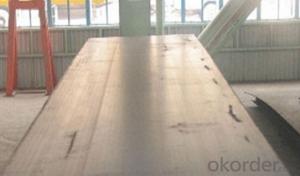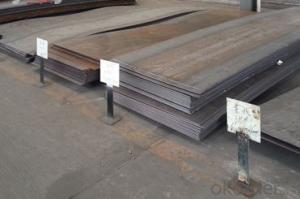Hot Rolled Carbon Steel Sheet A678 CNBM
- Loading Port:
- Qingdao
- Payment Terms:
- TT OR LC
- Min Order Qty:
- 10 pc
- Supply Capability:
- 30 pc/month
OKorder Service Pledge
Quality Product, Order Online Tracking, Timely Delivery
OKorder Financial Service
Credit Rating, Credit Services, Credit Purchasing
You Might Also Like
Quick Details
| Standard: | AISI, ASTM, DIN, GB, JIS | Grade: | A572,A573,A633,A678,A709,A710,G3101,G3136,etc | Thickness: | 1mm-200mm |
| Brand Name: | SHOU GANG GROUP, AN STEEL | Model Number: | Q235 | ||
| Type: | Steel Plate | Technique: | Hot Rolled | Surface Treatment: | Coated |
| Application: | widely | Special Use: | High-strength Steel Plate | Width: | 1000mm-3000mm |
| Length: | 1000mm-12000mm | Price Term: | FOB CIF CFR |
Packaging & Delivery
| Packaging Details: | standard seaworthy export packing or as the request of customers |
| Delivery Detail: | 10 days after deposit or according to customers' quantity |
Specifications
hot rolled carbon steel sheet
1.Thickness:1mm-200mm
2.Length:1000mm-12000mm
3.Width:1000mm-2000mm
hot rolled carbon steel sheet
| Product | HR steel plate prices carbon steel plate prices per kg |
| MOQ | 25 ton |
| Thickness | 1mm-200mm |
| Width | 1000mm-3000mm |
| Length | 1000mm-12000mm |
| Application | widely |
| Standard | AISI,ASTM,BS,DIN,JIS,GB,etc |
| Grade | A572,A573,A633,A678,A709,A710,G3101,G3136,etc |
| Tpye | Steel plate |
| Surfacing | Coated |
| Productive Technology | Hot Rolled & Cold Rolled |
| Port | |
| Payment Terms | L/C,T/T,Western Union,MoneyGram |
| Product Ability | 5000 tons per month |
| Delivery | 10 days after deposit or according to customers' quantity |
| Packing | standard seaworthy export packing or as the request of customers |
- Q:What is the difference between a hot rolled and cold rolled stainless steel sheet?
- The manufacturing process and resulting properties distinguish hot rolled stainless steel sheets from cold rolled ones. Hot rolled sheets are created by heating stainless steel to a high temperature and rolling it through a series of rollers to achieve the desired thickness. This method is typically used for larger sheets and results in a rougher surface finish. Additionally, hot rolled sheets are known for their inherent strength and malleability, making them suitable for various applications that require structural integrity. In contrast, cold rolled stainless steel sheets are produced by cooling the stainless steel to a lower temperature and passing it through rollers at room temperature. This process yields a smoother and more refined surface finish compared to hot rolled sheets. Cold rolled sheets are commonly preferred for precision-demanding applications such as automotive components, appliances, and electronic devices. Regarding mechanical properties, hot rolled stainless steel sheets generally possess a higher yield strength and lower ductility when compared to cold rolled sheets. This can be attributed to the grain structure formed during the hot rolling process, resulting in a more coarse and less uniform microstructure. Conversely, cold rolled sheets have a finer grain structure and higher ductility, making them more suitable for forming and bending operations. To summarize, the primary differences between hot rolled and cold rolled stainless steel sheets lie in the manufacturing process and the resulting properties. Hot rolled sheets exhibit a rougher surface finish, higher strength, and lower ductility, whereas cold rolled sheets possess a smoother surface finish, higher ductility, and are often preferred for precision-demanding and forming applications.
- Q:What is the cost of steel sheets?
- The cost of steel sheets can vary depending on various factors such as size, thickness, grade, and market conditions. It is recommended to contact suppliers or check current market prices for accurate and up-to-date information.
- Q:What are the different types of surface finishes available for steel sheets?
- Steel sheets come in a variety of surface finishes, each with its own purposes and aesthetic qualities. Some of the most common finishes include: 1. Hot rolled: Achieved by heating the steel and then rolling it, this finish creates a rough texture. It is commonly used for structural purposes where appearance is not the main concern. 2. Cold rolled: Unlike hot rolled, this finish is achieved at room temperature, resulting in a smoother and more refined surface. It is often used for applications that require precision or a visually appealing appearance. 3. Galvanized: Steel sheets are coated with a layer of zinc to provide excellent corrosion resistance. This finish is commonly used in outdoor or high-moisture environments. 4. Electro-galvanized: Similar to galvanized, this finish involves depositing a layer of zinc using an electrical current. It creates a thinner and more uniform coating. 5. Stainless steel: Chromium is added to the steel sheets to create a protective layer that prevents corrosion and staining. Stainless steel is known for its strength and resistance to chemicals, making it suitable for various applications. 6. Satin: This finish is achieved by brushing the steel surface with abrasive materials, resulting in a smooth and low-reflective appearance. It is commonly used for architectural and decorative purposes. 7. Mirror: Steel sheets with a mirror finish have a highly reflective surface achieved through progressive polishing. This finish is often used in decorative applications. 8. Painted: Steel sheets can be coated with paint to improve appearance and provide additional protection against corrosion. This finish offers a wide range of color options and customization possibilities. These are just a few examples of the available surface finishes for steel sheets. The choice of finish depends on the specific requirements of the application, including aesthetics, corrosion resistance, and functionality.
- Q:What are the common sizes of steel sheets?
- The common sizes of steel sheets vary depending on the application and industry. However, some standard sizes for steel sheets include 4x8 feet, 4x10 feet, and 5x10 feet. Additionally, steel sheets are also available in various thicknesses ranging from gauge 10 to gauge 30.
- Q:Can steel sheets be used for water drainage systems?
- Yes, steel sheets can be used for water drainage systems. Steel is a durable and corrosion-resistant material that can effectively handle the flow of water. It is commonly used in various drainage applications due to its strength and longevity.
- Q:How do steel sheets compare to galvanized sheets?
- Both steel sheets and galvanized sheets find extensive use across various industries and applications, but they possess distinguishing characteristics that render them appropriate for different purposes. Constructed from robust and enduring low carbon steel, steel sheets exhibit remarkable strength, making them suitable for a wide array of applications, including construction, automotive manufacturing, and fabrication. With varying grades and thicknesses available, steel sheets offer versatility in their usage. When adequately maintained, they provide exceptional strength and resistance against corrosion. Contrarily, galvanized sheets are essentially steel sheets coated with a zinc layer via galvanization. This coating forms a protective barrier against corrosion, thus extending the sheet's lifespan. Galvanized sheets are commonly employed in outdoor applications, where exposure to moisture and harsh weather conditions poses a concern, such as roofing, fencing, and outdoor signage. In comparison to steel sheets, galvanized sheets possess heightened corrosion resistance and tend to endure longer in outdoor environments. However, they may not exhibit the same level of strength as steel sheets and can be more costly due to the galvanization process. Moreover, the zinc coating imparts a distinctive lustrous appearance to galvanized sheets, resulting in a more visually pleasing finish. To summarize, steel sheets exemplify strength, versatility, and suitability for diverse applications, whereas galvanized sheets offer superior corrosion resistance and prove ideal for outdoor usage. The ultimate selection between the two hinges on project-specific requirements, considering factors such as strength, durability, corrosion resistance, and budget.
- Q:Can steel sheets be used for outdoor applications?
- Yes, steel sheets can be used for outdoor applications. Steel is a durable and weather-resistant material, making it suitable for various outdoor uses such as roofing, siding, fencing, and construction projects. It is capable of withstanding harsh weather conditions, including rain, wind, and sunlight, without significant deterioration. Additionally, steel sheets can be treated or coated to further enhance their resistance to corrosion, making them an ideal choice for outdoor applications.
- Q:Are the steel sheets suitable for high-temperature applications?
- Yes, steel sheets are suitable for high-temperature applications due to their excellent heat resistance and strength.
- Q:What is a fixed length steel plate?
- Please check the standard: GB/T706-2008 hot-rolled steel fixed length is in accordance with customer requirements made of length, usually 6 meters, 9 meters look
- Q:Are steel sheets suitable for swimming pool construction?
- Steel sheets are a great option for constructing swimming pools due to their strength and durability. They are well-known for their ability to withstand the weight of the water and the pressure applied to the pool walls, providing a stable and sturdy structure. Furthermore, steel sheets can be easily shaped and joined together in different sizes and forms, allowing for customized and flexible pool designs. In addition, steel is resistant to corrosion, which is essential for maintaining the pool's integrity, particularly when exposed to chlorinated water. This makes steel sheets a dependable and widely chosen material for swimming pool construction.
1. Manufacturer Overview |
|
|---|---|
| Location | |
| Year Established | |
| Annual Output Value | |
| Main Markets | |
| Company Certifications | |
2. Manufacturer Certificates |
|
|---|---|
| a) Certification Name | |
| Range | |
| Reference | |
| Validity Period | |
3. Manufacturer Capability |
|
|---|---|
| a)Trade Capacity | |
| Nearest Port | |
| Export Percentage | |
| No.of Employees in Trade Department | |
| Language Spoken: | |
| b)Factory Information | |
| Factory Size: | |
| No. of Production Lines | |
| Contract Manufacturing | |
| Product Price Range | |
Send your message to us
Hot Rolled Carbon Steel Sheet A678 CNBM
- Loading Port:
- Qingdao
- Payment Terms:
- TT OR LC
- Min Order Qty:
- 10 pc
- Supply Capability:
- 30 pc/month
OKorder Service Pledge
Quality Product, Order Online Tracking, Timely Delivery
OKorder Financial Service
Credit Rating, Credit Services, Credit Purchasing
Similar products
New products
Hot products
Related keywords





























